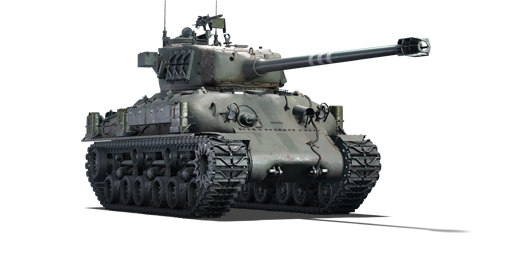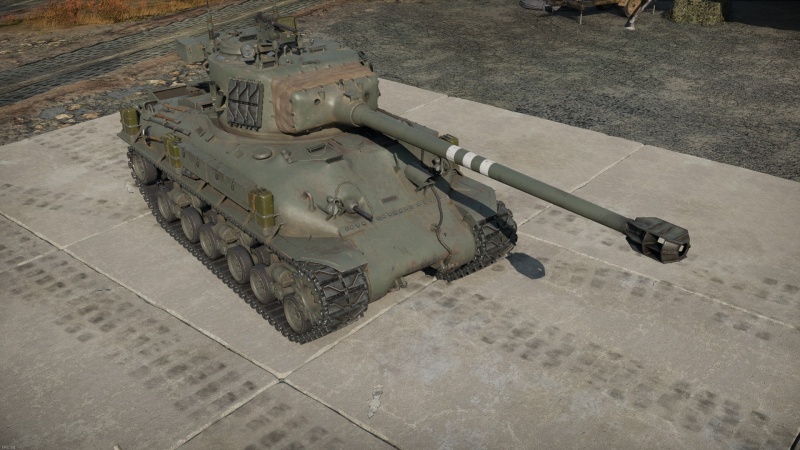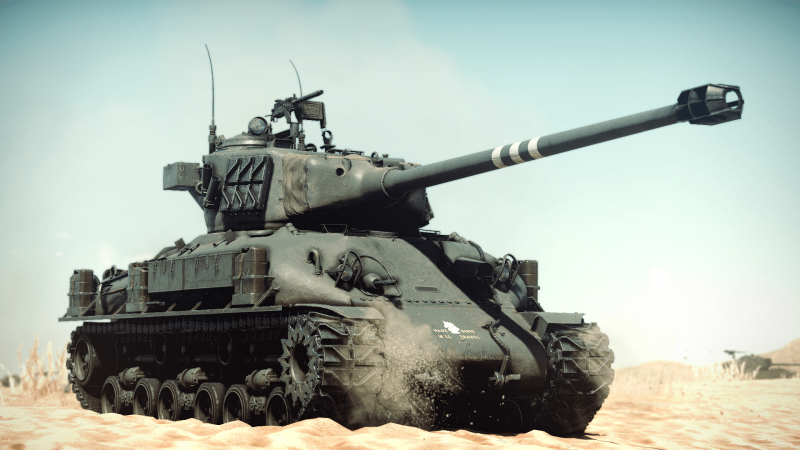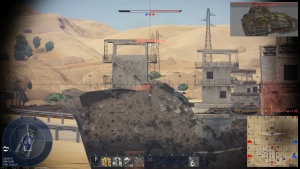M-51
| This page is about the Israeli medium tank M-51. For the premium version, see M-51 (W). |
Contents
Description
The M-51 was a further development of the M-50 Super Sherman. After the establishment of the Israeli State in 1948, the IAF faced a lot of conflicts with different nations, and thus it needed a cheap way to create a capable armoured force. The M-50 was developed, using the M4A4 and M4A1 chassis and a 76 mm cannon, however this was deemed very weak against more modern tanks like the T-54/55 that appeared in the following years. Thus, the M-51 was developed, using a 105 mm rifled cannon (the same used by the AMX-30). The tank saw conflict during the Yom Kippur War alongside Centurions and Patton tanks, in fact, the M-51 with its HEAT shell was the more capable tank to face the T-55 and T-62s armour, however the tank suffered from poor engine reliability, mediocre off-road mobility, and little to no protection against enemy tanks, ATGMs, or RPGs. Eventually the tanks were sold to Chile, where they were known as M-60.
The M-51, introduced in Update "Wind of Change", looks very similar to the M4A1 (76) W, however it's an up gunned version of the Sherman. It uses a powerful 105 mm cannon, however, unlike other Shermans, it does not have access to a stabilizer. Its HEAT shell is powerful enough to penetrate pretty much every enemy at its BR, even the Maus. However this is balanced by a lack of mobility and very weak armour, most times the vehicle will be destroyed from a single hit, and its off-road mobility as well as reverse speed are very bad for its BR, even when compared to heavy tanks. Thus it sees more success when it's used in ambushes or in a defensive playstyle, since rushing and staying in the frontlines is not recommended, instead, play safely and with the cover of your teammates.
General info
Survivability and armour
The hull armour is mostly inadequate. Almost every popular tank in the BR range can penetrate the tank's front with ease even when it is presented at an extreme angle, short of light tanks and SPAAs. Still, frontal armour can protect the tank from bombs and rockets. The side armour is quite weak and is arguable the weakest part of the tank, as even SPAA can penetrate it at various angles. The rear is technically the best protected side when it comes to hopeless situations - if the opponent hits too high, then shell bounces into tough turret and does nothing; if opponent hits too low, then engine might stop the shell. Unfortunately, tank's awful reverse speed does not allow it to charge with rear forward, so it can only be used defensively.
The turret armour is bad and good. Turret sides are unlikely to protect from anything but 20 mm SPAA, but the front is decent. The gun mantlet actually allows the turret to deflect long range shots from the 8.8 cm KwK 36 due to volumetric shells and can allow the tank to fight in hulldown position, but the turret's top is not cut off on the "mask" level, but higher. The actual roof is connected to it with 26 mm RHA plate, which is not even angled enough to bounce shells in the first place, and most of opponents in tank's rank are either extremely tall, have angle negating shells, or both. Because of this, if the M-51 is charging into high ground, it is easily destroyed before it can even fire, especially in AB. By keeping distance and vertical angle, the tank can reduce the probability of being penetrated.
Armour type:
- Rolled homogeneous armour (hull side bottom, hull roof - engine)
- Cast homogeneous armour (hull, turret, cupola)
| Armour | Front (Slope angle) | Sides | Rear | Roof |
|---|---|---|---|---|
| Hull | 63.5 mm (44°) Upper glacis 63.5 mm (cylindrical) Transmission housing 38.1 mm Hull corners |
38 mm (2-15°) Top 38 mm Bottom |
38 mm (14°) | 63.5 mm (46°) Front glacis 19.5 mm Crew compartment 20 mm Engine compartment 9.5-9.5+4 mm Engine vents |
| Turret | 55 mm (12°) Turret front 80 - 250 mm Gun mantlet |
51 mm (10-17°) | 51 mm 51 mm (65°) Bustle |
25.4 mm |
| Cupola | 63.5 mm (cylindrical) | 25.4 mm | ||
Notes:
- Suspension wheels are 15 mm thick, tracks are 20 mm thick, and torsion bars are 10 mm thick.
Mobility
Without upgrades, even in AB the tank will never be able to take initiative from opponents, as it accelerates poorly and loses a lot of momentum when turning at low/zero crew level - opponents will always be first to the capture point and almost always will react faster in combat.
With all the upgrades, it is still slower than most of other tanks, but it will feel far less clunky to drive and will more often reach maximum speed. It will also accelerate surprisingly fast, for how it performed before.
Remember, the reverse speed on this tank is only 3-5 km/h, combined with poor hull plating it requires the commander to make decisions count, or to not rely on mobility at all.
| Game Mode | Max Speed (km/h) | Weight (tons) | Engine power (horsepower) | Power-to-weight ratio (hp/ton) | |||
|---|---|---|---|---|---|---|---|
| Forward | Reverse | Stock | Upgraded | Stock | Upgraded | ||
| Arcade | 43 | 6 | 40 | 713 | 878 | 17.83 | 21.95 |
| Realistic | 38 | 5 | 407 | 460 | 10.18 | 11.5 | |
Modifications and economy
Armaments
Main armament
The gun fires HEAT and HE with characteristics typical of a rank IV SPG, but its velocity is very close to the default APHE (usually a bit slower), which makes learning curve less strict than it normally is. The tank is also reasonably tall, so HEAT does not lose a lot of power like with the SPG of the rank, which struggle with heavy tanks due to an insane angle of attack.
Gun accuracy is great even without the gun adjustment upgrade and with zero crew experience, but its vertical elevation speed is awful, and the gun is constantly tilted by changes of movement pace, which makes handling it difficult. This makes personal user skill to fire on move without braking a necessity.
The only way to reduce the tilt is to upgrade movement modules, as it reduces the tilt threefold. Due to the low gun elevation speed, the elevation mechanism upgrade is a must have, and it is generally a good idea to pull the gun up before charging downhill, as to not disarm the tank in process, particularly at low crew level.
| 105 mm M-51 | Turret rotation speed (°/s) | Reloading rate (seconds) | |||||||||||
|---|---|---|---|---|---|---|---|---|---|---|---|---|---|
| Mode | Capacity | Vertical | Horizontal | Stabilizer | Stock | Upgraded | Full | Expert | Aced | Stock | Full | Expert | Aced |
| Arcade | 56 | -8°/+20° | ±180° | N/A | 22.8 | 31.6 | 38.4 | 42.5 | 45.2 | 9.75 | 8.63 | 7.95 | 7.50 |
| Realistic | 14.3 | 16.8 | 20.4 | 22.6 | 24.0 | ||||||||
Ammunition
| Penetration statistics | |||||||
|---|---|---|---|---|---|---|---|
| Ammunition | Type of warhead |
Penetration @ 0° Angle of Attack (mm) | |||||
| 10 m | 100 m | 500 m | 1,000 m | 1,500 m | 2,000 m | ||
| OCC 105 F1 | HEAT | 400 | 400 | 400 | 400 | 400 | 400 |
| OE 105 F1 Mle.60 | HE | 25 | 25 | 25 | 25 | 25 | 25 |
| Shell details | ||||||||||||
|---|---|---|---|---|---|---|---|---|---|---|---|---|
| Ammunition | Type of warhead |
Velocity (m/s) |
Projectile mass (kg) |
Fuse delay (m) |
Fuse sensitivity (mm) |
Explosive mass (TNT equivalent) (kg) |
Ricochet | |||||
| 0% | 50% | 100% | ||||||||||
| OCC 105 F1 | HEAT | 800 | 10.95 | 0.05 | 0.1 | 1.02 | 62° | 69° | 73° | |||
| OE 105 F1 Mle.60 | HE | 800 | 12.1 | 0 | 0.1 | 2 | 79° | 80° | 81° | |||
| Smoke shell characteristics | ||||||
|---|---|---|---|---|---|---|
| Ammunition | Velocity (m/s) |
Projectile mass (kg) |
Screen radius (m) |
Screen deploy time (s) |
Screen hold time (s) |
Explosive mass (TNT equivalent) (g) |
| OFPH 105 F1 | 600 | 11.4 | 20 | 5 | 25 | 50 |
HEAT shells destroy any tank regardless of its armour. They can be used at point blank range to knock out Panthers with a single shot by hitting their hull straight to the middle. They can also be used in typical HEAT fashion to bombard any enemy 600 m away over a hill, even without direct sight - returned APHE fire will not hit the tank back, since it's generally a bit faster, and even if there is an artillery genius on the other side, the gun mask should be able to handle it.
The HE shell is nice to have. Even if it's difficult to memorize which tank's roofs it can penetrate, the HE can be used to bully sneaky light tanks and beat certain SPGs like the Type 75 SPH.
Ammo racks
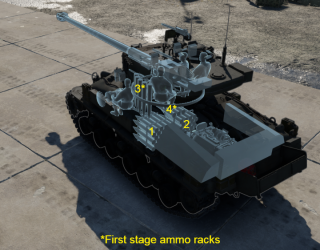
| Full ammo |
1st rack empty |
2nd rack empty |
3rd rack empty |
4th rack empty |
Visual discrepancy |
|---|---|---|---|---|---|
| 56 | 33 (+23) | 9 (+47) | 4 (+52) | 1 (+55) | No |
Machine guns
| 7.62 mm M1919A4 | ||||
|---|---|---|---|---|
| Mount | Capacity (Belt) | Fire rate | Vertical | Horizontal |
| Pintle | 750 (250) | 500 | -10°/+60° | ±180° |
| Coaxial | 4,750 (250) | 500 | N/A | N/A |
Usage in battles
The M-51 has poor armour for its BR, which is why you should never get into a brawl. Even though the overall armour might not be suited for close-range engagements, the hull armour is kind of decent at long ranges but is really good against bombs and rockets. Pick off targets from long range and avoid being spotted so do not hang around in one spot for too long. Your eather thin armour means that you cannot risk taking even a single hit especially from the side as you will be destroyed instantly. Aerial opponents are also a threat.
- Enemies worth noting
- Panther D - If the Panther presents its front, then shoot the left side of the mantlet where the gunner and the commander sits, which will effectively disable it. You can then try and shoot the front to knock out the rest of the crew.
- IS-2 - This Soviet tank has better armour than you but your excellent 105 mm gun with HEAT shells should have no problem penetrating it. However, you must make sure that you shoot first to disable its gunner. Shoot at the turret if the IS-2 is presenting its front. The IS-2 has poor gun depression which can be used against it on hilly maps when it attempts to climb up a hill.
Pros and cons
Pros:
- 400 mm penetration HEAT launcher is a death sentence for any tank
- Gun mantlet can block or bounce inaccurate shots, decent for hulldown tactics
- The gun is reasonably accurate even when stock and with untrained crew
- There are three of them, which means you only have to pay for the repair once (there are also free repairs several times)
- Gun scope has great zoom
- Decent gun depression
Cons:
- Very bouncy gun; paired with the poor vertical gun elevation speed any panic on commander's side is fatal
- HEAT rounds are highly unreliable with mostly poor post-penetration damage
- No .50 cal heavy machine gun
- Fire-on-the-move techniques take time to be fully mastered
- Turret armour has a fatal flaw which makes it weak when charging into high ground (or in general against good snipers in AB)
- The hull armour offers little protection at the rank, giving the vehicle a low survivability
- When initially unlocked, must be used with a level 1 crew with no expert training against elite crews of other nations - very high personal skill requirement or patience strain
History
The M-51 was developed from an M-50 tank, whose project started in 1954 after Israel bought several AMX-13 tanks from France, although their armour protection was deemed inadequate. Israel purchased a number of the 75 mm guns in order to fit them onto M4 Sherman hulls as they constituted the backbone of the IDF tank force at that time. In 1955, a prototype turret was sent from France to Israel and Israeli Ordnance Corps military facilities began to up-gun the Sherman tanks with the French guns. The first 50 M-50 tanks were based on an M4A4 hull with a Continental R-975 gasoline engine and VVSS suspension. However, increased weight and narrow tracks of the tank, led to poor offroad mobility, so the rest of the M-50 were using M4A1 hulls with HVSS suspension and a Cummins VT-8-460 diesel engine instead. In total, about 300 M-50 Shermans were built by 1964.
In the 1960s, 180 M-50 Shermans were fitted with a shortened French 105 mm Modèle F1 gun with a barrel shortened to 51 calibres from the original 56. It was also equipped with a unique double-baffle muzzle brake and ammunition had to be altered to use a smaller cartridge. M4A1 hull and T23 turret from 76 mm gun-armed Shermans were used for the conversion. Both the M-50 and M-51 saw action during Six-Day Warfighting WWII era armour such as the T-34-85 of the Egyptian Army and newer tanks like the T-54/T-55 and T-62 series. The tanks saw action also in the 1973 Yom Kippur War alongside Israeli-upgraded Centurion and M48/M60 tanks. The M-51s gun was capable of penetrating its adversaries thanks to HEAT ammunition. M-50 with diesel engines and M-51 were retired between the 1970s and 1980s. About 100 M-51s were sold to Chile in the 1980s, where some were fitted with IMI-OTO 60 mm HVMS gun and referred to as M-60. Chile used them until 1999 when they were replaced by Leopard 1 MBTs.
Media
- Skins
- Videos
See also
External links
Paste links to sources and external resources, such as:
- topic on the official game forum;
- other literature.
| Israeli Ordnance Corps (חיל החימוש) | |
|---|---|
| Medium Tanks | M-51 · M-51 (W) |
| MBTs | |
| Magach | Magach 1 · Magach 2 · Magach 3 · Magach 3 (ERA) · ▃Magach 3 (ERA) · Magach 5 |
| Magach 6 · Magach 6A · Magach 6B · Magach 6C · Magach 6R · Magach 6M · Gal Batash | |
| Sho't | Sho't · Sho't Kal Alef · Sho't Kal Gimel · Sho't Kal Dalet · ▄Sho't Kal Dalet |
| Tiran | Tiran 4 · Tiran 4S |
| Merkava | ▃Merkava Mk.1 · Merkava Mk.1B · Merkava Mk.2B · ▃Merkava Mk.2B · Merkava Mk.2D |
| Merkava Mk.3B · Merkava Mk.3C · ▃Merkava Mk.3D · Merkava Mk.4B · Merkava Mk.4M | |
| Tank destroyers | Zachlam Tager |
| See Also | Chrysler Defense · Department of Tank Design · Morozov Design Bureau |
| Israel medium tanks | |
|---|---|
| M-51 | M-51 · M-51 (W) |
| Magach | Magach 1 · Magach 2 · Magach 3 · Magach 3 (ERA) · Magach 5 · Magach 6 |
| Magach 6A · Magach 6B · Magach 6B Gal · Gal Batash · Magach 6C · Magach 6M · Magach 6R · Magach Hydra · Magach 7C | |
| Tiran | Tiran 4 · Tiran 4S · Tiran 6 |
| Sho't | Sho't · Sho't Kal Alef · Sho't Kal Gimel · Sho't Kal Dalet |
| Merkava | Merkava Mk.1B · Merkava Mk.2B · Merkava Mk.2D · Merkava Mk.3B · Merkava Mk.3C · Ra'am Sagol |
| Merkava Mk.4B · Merkava Mk.4M · Merkava Mk.4 LIC | |


